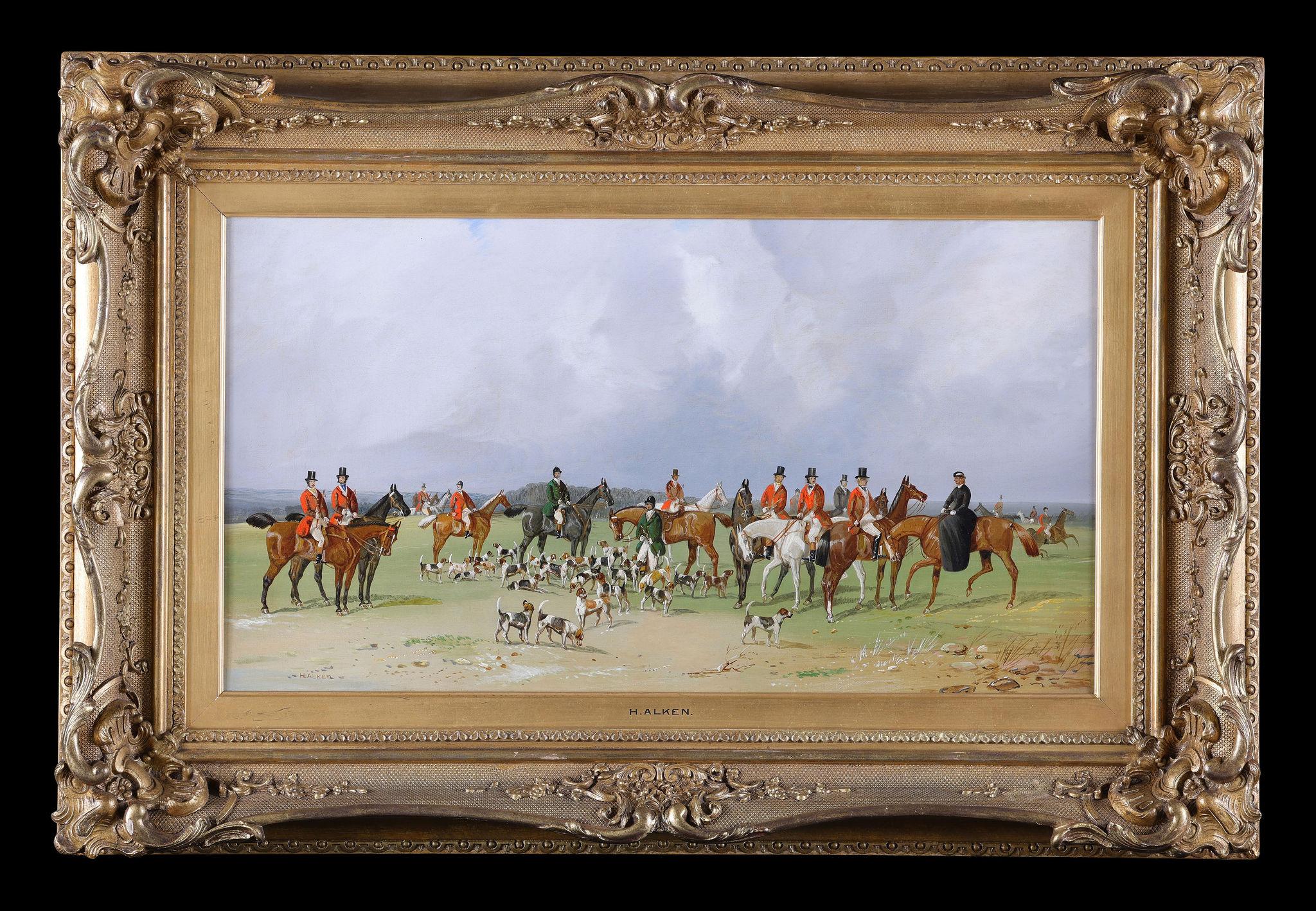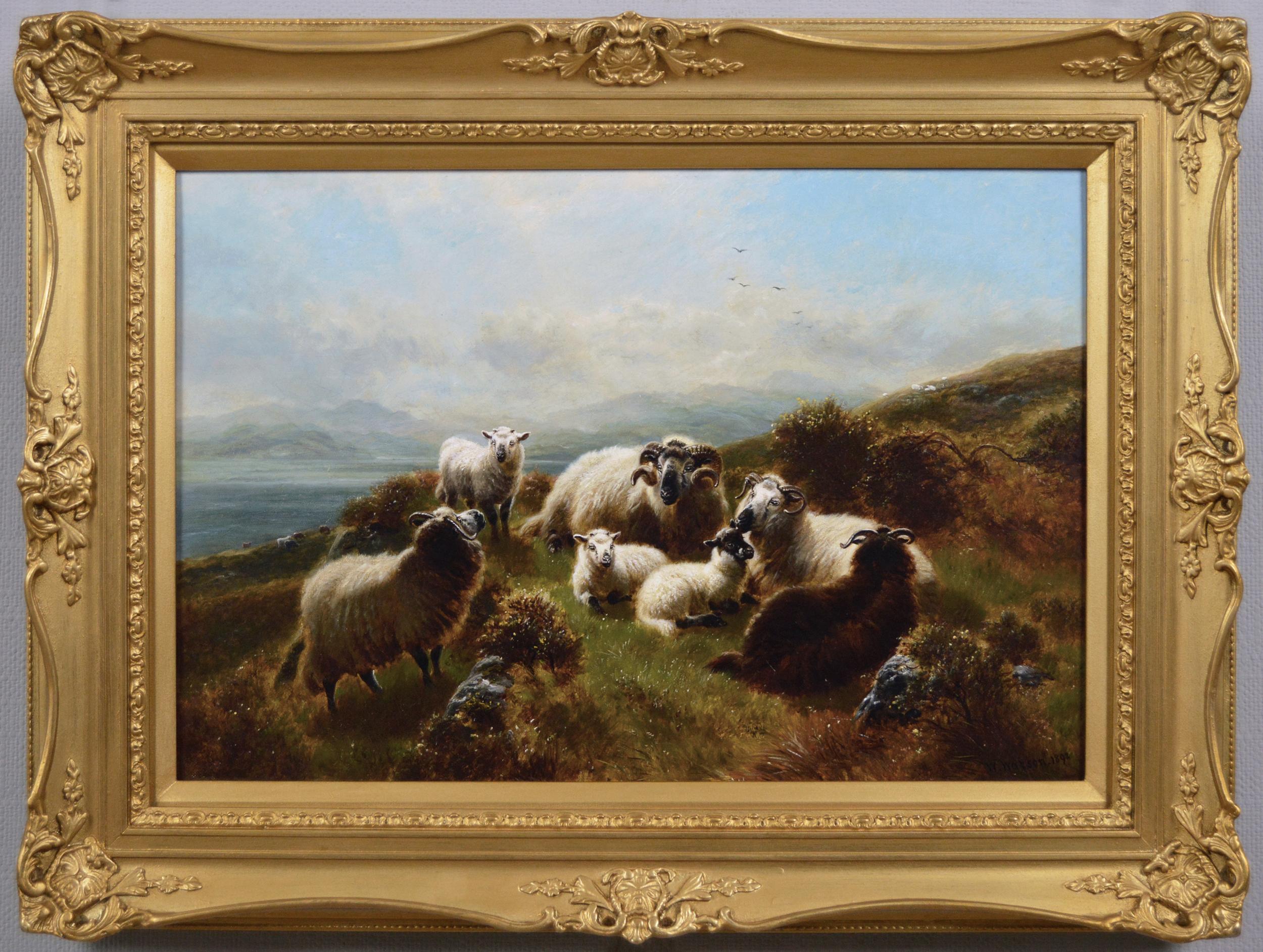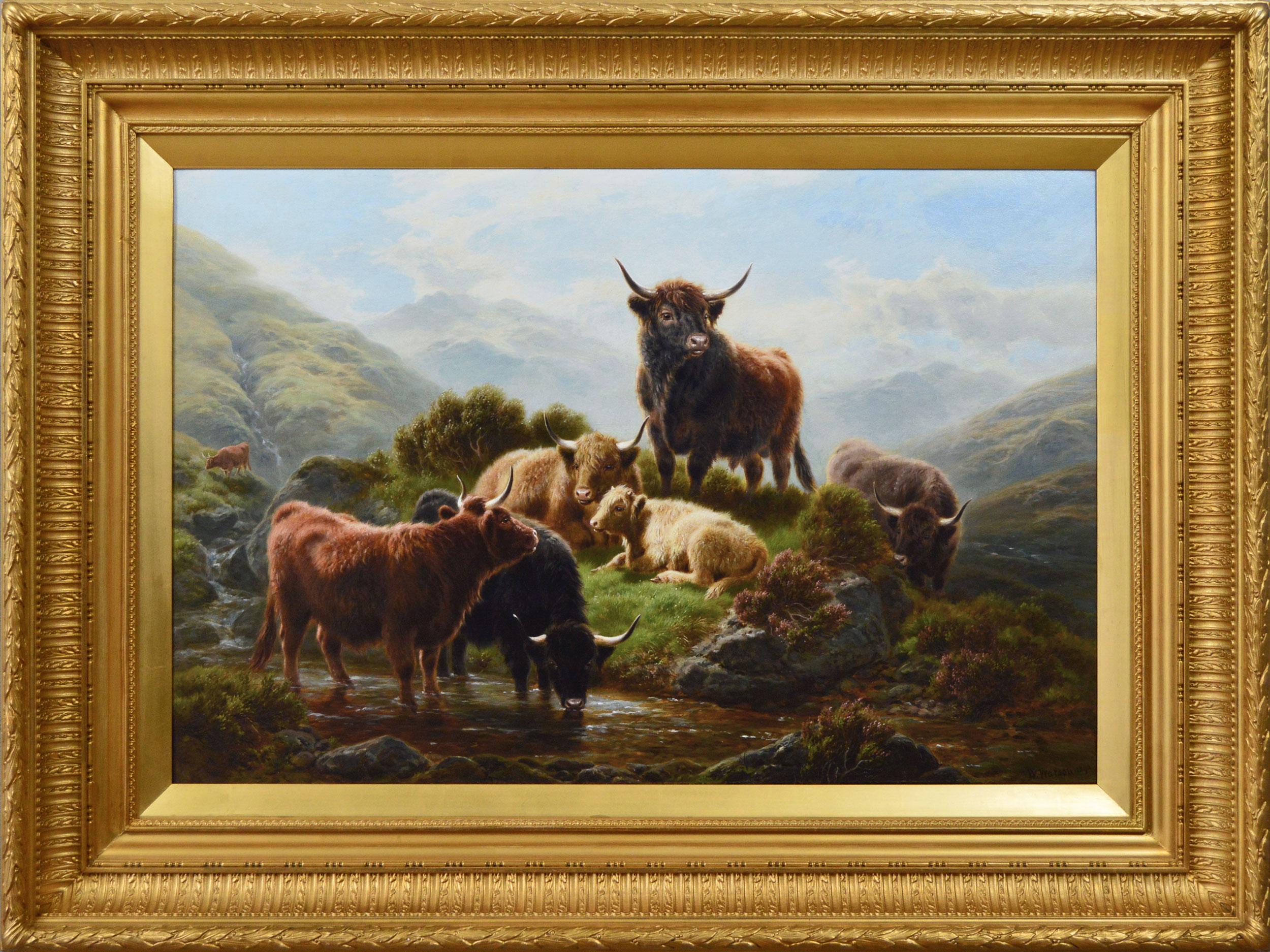Items Similar to Cattle Watering in a Landscape - British 19th century art Victorian oil painting
Want more images or videos?
Request additional images or videos from the seller
1 of 14
Cattle Watering in a Landscape - British 19th century art Victorian oil paintingCirca 1855
Circa 1855
About the Item
This lovely British Victorian landscape oil painting is attributed to noted artist Sam Bough. It was painted circa 1855 after Bough had moved to Hamilton Lanarkshire in Scotland to focus on painting landscapes along side fellow artist Alexander Frazer. The composition is several cattle watering in a stream under the boughs of an ancient tree. There is superb impasto, for example on the clouds and this is a charming 19th century oil painting.
Provenance. London estate.
Condition. Oil on canvas, 29 inches by 16 inches unframed and in good condition.
Frame. Housed in an ornate gilt Victorian frame, 36 inches by 23 inches framed and in good condition.
Samuel Bough RSA (1822–1878) was an English-born landscape painter who spent much of his career working in Scotland. He was born the third of five children in Abbey Street, Carlisle in northern England, the son of James Bough (1794-1845), a shoemaker, and Lucy Walker, a cook. He was raised in relative poverty, but with a keen encouragement in the arts. He was self-taught but mixed with local artists such as Richard Harrington and George Sheffield, and was strongly influenced by the work of Turner. After an unsuccessful attempt to live as an artist in Carlisle he obtained a job and as a theatre scenery painter in Manchester in 1845, later also working in Glasgow in the same role. Encouraged by Daniel Macnee to take up landscape painting he moved to Hamilton from 1851-4 and worked there with Alexander Fraser. In 1854 he moved to Port Glasgow to work on his technique of painting ships and harbours. His paintings were noted for their sensitivity to atmosphere and light, were often of cloudy shorelines and busy harbours. He also began supplementing his income by illustrating books, before moving to Edinburgh in 1855. On coming to Edinburgh he lived in a terraced house at 5 Malta Terrace in the Stockbridge area of the city. Following Turner's example, he became a skilful painter of seaports. He was buried in Dean Cemetery Edinburgh on 23 November 1878. The grave bears a bronze medallion of his head by William Brodie and faces over a southern path to the south terrace. The artist’s works were admired by the famous author of Treasure Island, Robert Louis Stevenson, who wrote his obituary after his death.
- Attributed to:Samuel Bough (1822 - 1878, Scottish)
- Creation Year:Circa 1855
- Dimensions:Height: 23 in (58.42 cm)Width: 36 in (91.44 cm)Depth: 2 in (5.08 cm)
- Medium:
- Movement & Style:
- Period:
- Condition:
- Gallery Location:London, GB
- Reference Number:1stDibs: LU853113244342
About the Seller
5.0
Platinum Seller
These expertly vetted sellers are 1stDibs' most experienced sellers and are rated highest by our customers.
1stDibs seller since 2018
398 sales on 1stDibs
Typical response time: <1 hour
- ShippingRetrieving quote...Ships From: London, United Kingdom
- Return PolicyA return for this item may be initiated within 14 days of delivery.
More From This SellerView All
- Portrait of Two Horses in a Landscape - British 19thC equine art oil paintingBy George ColeLocated in London, GBThis lovely British Victorian oil painting is attributed noted landscape and animal artist George Cole ans ascribed verso. Painted in 1840 it is a superb portrait of two horses, one ...Category
1840s Victorian Animal Paintings
MaterialsOil
- Landscape with Cottages and Sheep - British Victorian 1850's art oil paintingBy William Henry CromeLocated in London, GBThis superb oil on panel painting is by British Victorian artist William Henry Crome, son of artist John Crome, founder of the Norwich School. Painted circa 1850 the painting depicts...Category
19th Century Victorian Landscape Paintings
MaterialsOil
- Derwent Water Lake District Landscape - British Victorian art oil paintingBy William DaviesLocated in London, GBThis lovely British Victorian landscape oil painting is by artist William M Davies. It was painted in 1898 and the location is Derwent water at Borrowdale, in Cumberland in the Lake ...Category
Late 19th Century Victorian Landscape Paintings
MaterialsOil
- Gate Crag Borrowdale Landscape - British 19thC art Lake District oil paintingBy William DaviesLocated in London, GBThis lovely British Victorian landscape oil painting is by artist William M Davies. It was painted in 1898 and the location is Gate Crag Borrowdale, in Cumberland in the Lake Distric...Category
Late 19th Century Victorian Landscape Paintings
MaterialsOil
- Cattle Grazing in a Wooded Landscape - British Victorian art oil paintingBy Thomas Baker of LeamingtonLocated in London, GBThis lovely British Victorian oil painting is by noted 19th century landscape artist Thomas Baker of Leamington. It was painted on 18th September 1854 as a special commission. The co...Category
1850s Victorian Animal Paintings
MaterialsOil
- Working Horses in Scottish Landscape - Scottish 1920s art Impressionist paintingBy George SmithLocated in London, GBThis lovely Impressionist Colourist oil painting is a fine example of the work of noted Scottish landscape and animal artist George Smith. He was particularly known for his paintings...Category
1920s Impressionist Animal Paintings
MaterialsOil
You May Also Like
- The Hunt RestingBy Henry AlkenLocated in St. Albans, GBHenry Thomas ALKEN 1785 – 1851 A very typical example of Alken's work in a beautifully presented original antique frame. Alken's work is highly collectable and this is worthy of any...Category
1840s Victorian Landscape Paintings
MaterialsOil
- Pair of landscape hunting scenes with wild boarLocated in Moreton-In-Marsh, Gloucestershire**PLEASE NOTE: EACH PAINTING INCLUDING THE FRAME MEASURES 17 INCHES X 20 INCHES** Godfrey Douglas Giles British, (1857-1941) Wild Boar & her Young in an Indian Landscape & Pursuit o...Category
Early 20th Century Victorian Animal Paintings
MaterialsOil, Panel
- 19th Century Highland landscape oil painting of sheep near Loch AweLocated in Moreton-In-Marsh, GloucestershireWilliam Watson Jnr British, (1847-1921) On the Mountains, Loch Awe Oil on canvas, signed & dated 1892, further inscribed verso Image size: 12.5 inches x 18.5 inches Size including frame: 18.5 inches x 24.5 inches A wonderful painting of Highland sheep resting near Loch Awe by William Watson Jnr. Loch Awe is located in Argyll and Bute in the Scottish Highlands and this scene is taken from the mountain side overlooking the loch. William Watson was born in Islington in 1847, the son of the London miniature painter William John Watson (1810-1871) and his wife Caroline (née Butcher). His brothers Charles Watson (1837-1900) and Robert Watson (1855-1921) were also artists. His father seems to have travelled around and after spending time in Brighton, the family moved to Bransford Road in Worcester during the early part of the 1860’s. As well as being taught by his father, Watson received his early training in the studio of Sir Francis Grant PRA (1803-1878). He later became a pupil of Sir Edwin Henry Landseer RA (1802-1873) and Rosa Bonheur (1822–1899). Both Landseer and Bonheur had a great influence on his work and he began specialising in scenes of cattle and sheep. By 1866 he had become a full time artist and began exhibiting at the Royal Society of British Artists. Perhaps to take advantage of the inspiring scenery, Watson moved to Birkenhead, Cheshire where in 1871 he met and married Eleanor Davies who was from Caernarvonshire. Four of their children Sidney Watson (1881-1931), Caroline Ellen...Category
19th Century Victorian Animal Paintings
MaterialsCanvas, Oil
- 19th Century exhibition size landscape oil painting of Sheep on a cliffBy Charles Jones (b.1836)Located in Moreton-In-Marsh, GloucestershireCharles Jones British, (1836-1892) Sheep Resting Oil on canvas, signed with monogram & dated 1877, further inscribed verso Image size: 35 inches x 59 inches Size including frame: 47 inches x 71 inches Exhibition Size Painting A fantastic exhibition sized landscape painting of sheep on a cliff top by the coast by Charles ‘Sheep’ Jones. At the time he produced this painting, Jones was living at Heathercroft, Balham Hill in London. Given the size and quality of the work it was most likely an exhibition piece. The topography and landscape suggest that this is the Dorset coast, one of his favourite places to paint. Charles Jones was an animal painter who was born in Stepney, London in 1836. He was the son of the artist Samuel John Egbert Jones (1797-1861) and Dinah Jones. He lived with his parents and 9 siblings in Mile End and was a pupil of his father. In September 1859, he married Frances Rosalinda Downe, who was born in America. His son Arthur Bertram Loud (1863-1930) also became an artist. They lived at 12 Hayes Place, Lisson Grove from where he made his debut in London at the Royal Academy in 1861. He also exhibited at the British Institution, Suffolk Street, New Watercolour Society, Royal Institute of Oil Painters and the Royal Institute of Painters in Watercolours. By 1867, he had become a successful artist and they had moved to 7 Paragon Place, Brixton Hill. From 1874 he lived at Heathercroft, Balham Hill where he spent the rest of his life. Jones became well known for specialising in paintings of sheep, cattle and deer in landscape settings. He spent his time travelling around visiting areas such as Devon, Dorset, Kent, Sussex and the Highlands. However, it is for his skilful painting of sheep that he is perhaps best known, and for which earned him the nickname of ‘Sheep’ Jones. As well as the major London galleries, he also exhibited provincially at various locations including: the Royal Cambrian Academy where he was elected a member in 1886, the Glasgow Institute of Fine Arts, Manchester City Art Gallery, Royal Hibernian Academy, Royal Society of British Artists, Birmingham and the Walker Art Gallery, Liverpool. Some of the smaller more intimate galleries he exhibited at were Arthur Tooth & Sons and Thomas...Category
19th Century Victorian Animal Paintings
MaterialsCanvas, Oil
- 19th Century Scottish landscape oil painting of a figure with Highland CattleBy Henry GarlandLocated in Moreton-In-Marsh, GloucestershireHenry Garland British, (1834-1913) Driving the Cattle ‘Hame’ Oil on canvas, signed & further inscribed & dated 1895 verso Image size: 32.25 inches x 27.25 inches Size including fram...Category
19th Century Victorian Animal Paintings
MaterialsOil, Canvas
- 19th Century Scottish landscape oil painting of Highland cattle at Glen GoilBy William WatsonLocated in Moreton-In-Marsh, GloucestershireWilliam Watson Jnr British, (1847-1921) Up Glen Goil, West Highlands Oil on canvas, signed & dated 1892, further inscribed verso Image size: 23.5 inches x 35.5 inches Size including frame: 36.25 inches x 48.25 inches This highly atmospheric and well executed painting by William Watson Jnr depicts Highland Cattle watering at Glen Goil. Glen Goil is a valley area of Argyll and Bute in the West Highlands. It is situated at the junction of Hell’s Glen and Gleann Mor and has the river Goil flowing through. Located around 2 miles from Lochgoilhead, it is well known as an area of outstanding natural beauty. Watson made several trips to the Highlands and produced a number of paintings of the locality, many of which included highland cattle such as this fine example. Another painting by him of Glen Goil is held by the Walker Art Gallery, Liverpool. William Watson was born in Islington in 1847, the son of the London miniature painter William John Watson (1810-1871) and his wife Caroline (née Butcher). His brothers Charles Watson (1837-1900) and Robert Watson (1855-1921) were also artists. His father seems to have travelled around and after spending time in Brighton, the family moved to Bransford Road in Worcester during the early part of the 1860’s. As well as being taught by his father, Watson received his early training in the studio of Sir Francis Grant PRA (1803-1878). He later became a pupil of Sir Edwin Henry Landseer RA (1802-1873) and Rosa Bonheur (1822–1899). Both Landseer and Bonheur had a great influence on his work and he began specialising in scenes of cattle and sheep. By 1866 he had become a full time artist and began exhibiting at the Royal Society of British Artists. Perhaps to take advantage of the inspiring scenery, Watson moved to Birkenhead, Cheshire where in 1871 he met and married Eleanor Davies who was from Caernarvonshire. Four of their children Sidney Watson (1881-1931), Caroline Ellen Watson (1871-1947), William Robert Charles Watson (1873-1928) and Walter James Watson...Category
19th Century Victorian Animal Paintings
MaterialsCanvas, Oil
Recently Viewed
View AllMore Ways To Browse
Oil Rodney Charman
Oil Seacapes
Pamela Smith Hudson
Phineas Paist
Pierre Follie
Princeton Watch Company
Raymond Thibesart On Sale
Retro Alpina Watch
Robert Leepin
Rocky Tableau
Sevilla Saez
Theodore Carlton
Thomas Edwin Mostyn On Sale
Vadim Dolgov On Sale
Bertram Hartman On Sale
Boston Bruins
Charles Lees On Sale
Daniel Augenstein





